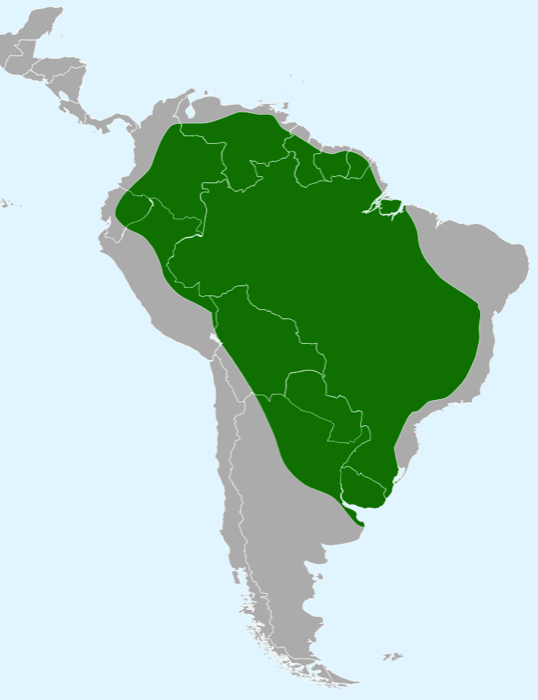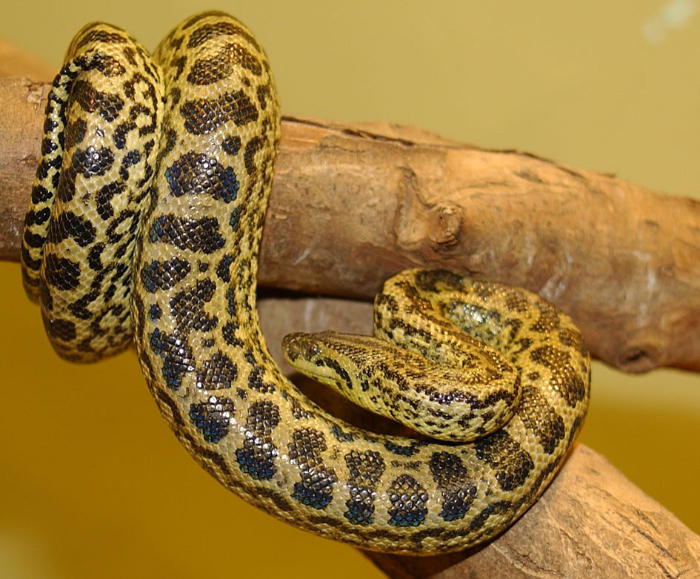Anaconda
Anaconda
Although little-known outside South America until the advent of a certain Hollywood movie, Anacondas have long been a source of awe for the region's visitors and inhabitants. They're the world's biggest snake - perhaps not by length, but certainly in size and power.
Anaconda
The bigger size of the anaconda, compared to other large snakes such as pythons, is largely due to its aquatic nature. Life in the water helps support the anaconda's heavier weight and girth - making the snakes fatter and more muscular than its land-based cousins. The extra muscle mass means that an anaconda weighs about 70% more than a python of equivalent length - with the largest anacondas weighing in the 150-200kg range. Typical lifespan is in the range 10-15 years, although some individuals have reached around 25 years.
Fortunately, unlike the snakes of the movie, anaconda aren't driven by insatiable appetites. Their meals are infrequent - often with intervals of several months. The digestion of a single meal can take two weeks or more to digest once the prey has been swallowed. The indigestible bones are eventually regurgitated. The period when digesting it's meal, can be dangerous for anacondas, since they only have limited mobility, and generally just stay where they are. However, in the event of danger they can quickly regurgitate the semi-digested meal, freeing themselves up to escape - although they'll need to catch another meal soon afterwards. In the
There are four different anaconda species, two of which - the Green Anaconda and Yellow Anaconda - are present in the Pantanal. The two other species not present are the Dark-Spotted Anaconda (found in Northern Brazil and Guiana) and Bolivian Anaconda (found in the Bolivian Amazon regions).
Fortunately, unlike the snakes of the movie, anaconda aren't driven by insatiable appetites. Their meals are infrequent - often with intervals of several months. The digestion of a single meal can take two weeks or more to digest once the prey has been swallowed. The indigestible bones are eventually regurgitated. The period when digesting it's meal, can be dangerous for anacondas, since they only have limited mobility, and generally just stay where they are. However, in the event of danger they can quickly regurgitate the semi-digested meal, freeing themselves up to escape - although they'll need to catch another meal soon afterwards. In the
There are four different anaconda species, two of which - the Green Anaconda and Yellow Anaconda - are present in the Pantanal. The two other species not present are the Dark-Spotted Anaconda (found in Northern Brazil and Guiana) and Bolivian Anaconda (found in the Bolivian Amazon regions).
Green Anaconda
The Green Anaconda, Eunectes murinus, is the largest of the four species - reaching around 6.6m or 22 ft in length. However, specimens found in the Pantanal are generally smaller than those found further north in the Amazon. This may simply be a matter of longevity - as anacondas continue growing throughout their life, and the less human interference in remote regions of the Amazon may be more conducive to a longer life span. No maximum size limit has been officially determined for anacondas. There are old stories of from the Amazon region telling of snakes reaching 9m (30ft), and even exceeding 18m (60ft). These are almost certainly exaggerations or simple misjudgement - as estimating size of a coiled snake can be surprisingly hard. In one experiment, several people were asked to estimate the length of an anaconda of known size - with almost everyone significantly overestimating. Females are generally much bigger and heavier than males, with a typical adult length of around 4.6m (15 ft). By contrast males typically average around 3m (10 ft).
Green anacondas are olive green in colour, with a pattern of dark splotches running along the length of it's upper body - helping provide camouflage amid aquatic vegetation in shallow water. Eyes and nostrils are set high on the head - allowing the snake to see and breath when swimming while keeping its body submerged.
Green anacondas are olive green in colour, with a pattern of dark splotches running along the length of it's upper body - helping provide camouflage amid aquatic vegetation in shallow water. Eyes and nostrils are set high on the head - allowing the snake to see and breath when swimming while keeping its body submerged.
Yellow Anaconda
Yellow Anacondas are the smaller of the two pantanal-based anaconda species, although they're the most common of the two. These grow to an average size of of 3.3 to 4.4 m (11 to 14 ft). As their name states, they're yellowish in colour, with dark spots which are larger and more pronounced. However, in the wild, yellow anacondas often still appear olive green. The tell-tale sign to identify the yellow anaconda is the yellowish colour of its underside. The black circular markings along its back are also more likely to touch and merge, forming a more complicated pattern. The habitat and behaviour of the yellow anaconda is comparable with that of the green anaconda.
Green Anaconda
Scientific Name
Eunectes murinus
Local Name
Sucuri-verde
Description
Large snake typically reaching 4m length. Olive green with dark splotches along upper body.



Yellow Anaconda
Scientific Name
Eunectes notaeus
Local Name
Sucuri-amarela
Description
Slightly smaller than Green Anaconda. Yellowish in colour with strong dark patterning.
Behaviour and Habitat
Although anacondas appear ungainly and clumsy on land, water is their real element. They move through water and swamps with stealth and surprising easy. They can swim underwater - poking their head out to gauge the location of their prey. In this way they sneak up and strike quickly. They have six layers of sharp teeth, which are hooked so that attempts by prey to back out of the anaconda's mouth will tear the flesh. According to local pantaneiros, if bitten its necessary to push in slightly further - forcing the anaconda's mouth to open and to unhook from their teeth ... although most prey never get this opportunity since the bite is immediately followed by the snake lifting its victim and manoeuvring to coil itself around it. The prey is then quickly suffocated. Every time the prey breathes out, the coils tighten, preventing the prey from drawing any further breath. Once the struggle is over, the snake uncoils itself, then positions itself over the animal's head, opens its elastic jaw, and slowly stars ingesting the animal. The head-first strategy means that the legs of the prey fold back naturally - preventing obstructions and damage to the snake.
The anaconda's sharp teeth makes their bite very painful, which why locals give them a wide berth even though they're non-venomous. If bitten by an anaconda, there's a chance that the bite will become infected - so cleaning and disinfecting the wound is very important. In the wild, the anaconda's diet consists of jacaré, capybara, agouti, lizards, amphibians, and water fowl such as herons and jacana. Larger specimens will also capture various pantanal deer. There are also stories of anacondas eating cattle, which have some basis in fact. Although full-sized cattle are probably outside its capacity, local farmers have shown us photos of anaconda swallowing calves. Attacks on people are rare - but there are tales of fishermen in the Amazon who've disappeared off their boats, and children who've disappeared swimming. Whilst it is indeed possible for an anaconda to eat a human - most of the stories and images for this on the Internet appear to be false or photoshopped.
The anaconda's sharp teeth makes their bite very painful, which why locals give them a wide berth even though they're non-venomous. If bitten by an anaconda, there's a chance that the bite will become infected - so cleaning and disinfecting the wound is very important. In the wild, the anaconda's diet consists of jacaré, capybara, agouti, lizards, amphibians, and water fowl such as herons and jacana. Larger specimens will also capture various pantanal deer. There are also stories of anacondas eating cattle, which have some basis in fact. Although full-sized cattle are probably outside its capacity, local farmers have shown us photos of anaconda swallowing calves. Attacks on people are rare - but there are tales of fishermen in the Amazon who've disappeared off their boats, and children who've disappeared swimming. Whilst it is indeed possible for an anaconda to eat a human - most of the stories and images for this on the Internet appear to be false or photoshopped.
Reproduction
Anacondas breed once a year, usually in the latter part of the wet season, April-May. Prior to this, the female must hunt and eat a sizeable meal as she won't eat again for the next six or seven months. When ready, she releases pheromones or other chemical scents which attract many of the much smaller males her. The snakes entwine and coil themselves into what's known as a "mating ball". This is where the male snakes are essentially battling and positioning themselves so they can copulate - with the activity occurring almost exclusively in water. As with all constrictor species in Brazil, the anaconda doesn't lay eggs. The species is ovoviviparous - meaning that eggs are retained within the female's body until they're ready to hatch. As a result, anaconda give birth to live young. Litters range from 20-40, although can occasionally exceed this. The litters are typically split into three foetal sacks. New-born anacondas are about 70-80cm long and need to fend for themselves almost immediately - however, their small size and lack of defences makes them easy pickings for jacaré and herons.
Quick Facts
- Pantanal visitors sometimes witness struggles between anacondas and jacaré. Although anaconda prey on jacaré, they need to use stealth and strike quickly because, if it has a chance to respond, the jacaré's teeth can cause significant damage. If bitten, the anaconda will generally leave the fight to protect itself.
- Anaconda young are easy prey for herons, storks and jacaré in their first months of life.
- Although native to South America, anacondas (and large burmese pythons) are now established in the Florida everglades - which is a habitat very similar to the pantanal. These are believed to have resulted from pets set loose into the wild, and escapees from a pet breeding facility destroyed by Hurricane Andrew in 1992.
- The name "Anaconda" isn't derived from any Spanish, Portuguese or Amerindian words relating to snakes. Instead it is a Sinhalese word (from Sri Lanka). The name likely travelled as Portuguese sailors and colonists moved between portuguese settlements in Brazil and Asia - with "Anaconda" becoming a generic term for large snake in both locations.
Banner image: Green anaconda (Shutterstock/Patrick K. Campbell)


